Basic definition of 1-1-3 press defense
The 1-1-3 press defense is a basketball strategy that uses on-ball pressure and sideline traps to disrupt offensive flow, which in turn, limits scoring opportunities and generates turnovers.
Initial formation example of 1-1-3 press defense
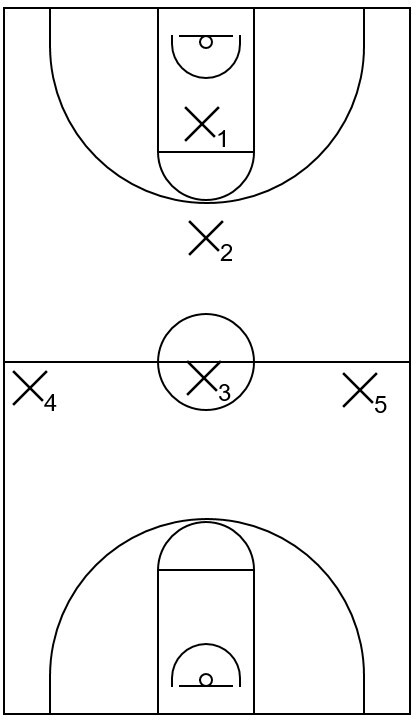
This section contains a diagram example of the initial formation for the 1-1-3 press defense.
Also, in regards to the diagram above as well as additional diagrams in later sections, each defensive player is indicated by the letter X shown alongside a number that is subscript.
For the purposes of this web page, this letter X and the adjacent subscript number symbolizes one of the standard basketball positions.
This general rule also applies to offensive players showcased in later sections as well.
However, for those instances, the letter X is not utilized. Instead, offensive players will simply be referred to as their respective number such as 1, 2, or 3.
Essentially, the defensive and offensive point guards are denoted as X1 and 1, respectively.
The defensive and offensive shooting guards are indicated as X2 and 2, respectively.
The defensive and offensive small forwards are represented as X3 and 3, respectively.
The defensive and offensive power forwards are signified as X4 and 4, respectively.
Finally, the defensive and offensive centers are denoted as X5 and 5, respectively.
Next, in relation to the initial formation on the diagram above, X1 begins in the offensive team’s backcourt slightly below the free throw line inside of the lane or key area.
Additionally, X2 occupies space in the offensive team’s backcourt at the top above the three-point arc.
In terms of the offensive team’s frontcourt, X3 begins near the center of the court while X4 and X5 cover the corner areas near the half court line.
General meaning behind the 1-1-3 numbering style
Essentially, it is called 1-1-3 because each digit represents the general alignment for the defensive players on the court.
To give more clarity of this concept, the digits between dashes represent the number of defensive players that will be located in a certain region of the court, typically based on the front, the middle, or the back.
Also, more dashes in a numbering format generally means more regions for the players to occupy on the court.
Basically, one dash would generally represent two regions of the court that players would fill.
An example of that would be the 2-3 zone defense, which contains two players in the front region and three players in the back region.
Furthermore, two dashes would typically signify three regions for players to occupy on the court.
An example of that would be this particular press defense, which contains one player in the front region, one player in the middle region, and three additional players in the back region.
In a similar fashion, three dashes would usually be indicative of four regions that players would fill on the court.
An example of that would be the 1-1-2-1 press defense in which the players will align in four regions on the court from the front to the back.
The diagram below showcases a demonstration of this concept.
Initial formation of 1-1-3 press defense with regions
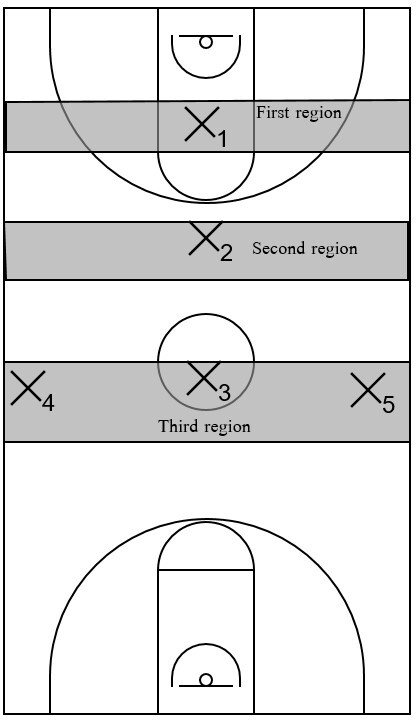
This is an example diagram of the 1-1-3 press showcasing one or more defensive players within different regions on the court during the initial formation, represented by the light gray-shaded boxes.
The first region contains one player, who is X1 for this example. The second region contains another player, who is X2 for this example.
The third region contains three players, who are X3, X4, and X5 for this example.
Affiliate Disclosure: I may earn a commission on qualifying purchases made through the links below.
Examples of 1-1-3 press defensive rotations
This section contains defensive rotations for the 1-1-3 press that could be potentially implemented to disrupt offensive flow.
Example 1: Initial defensive pressure in the backcourt
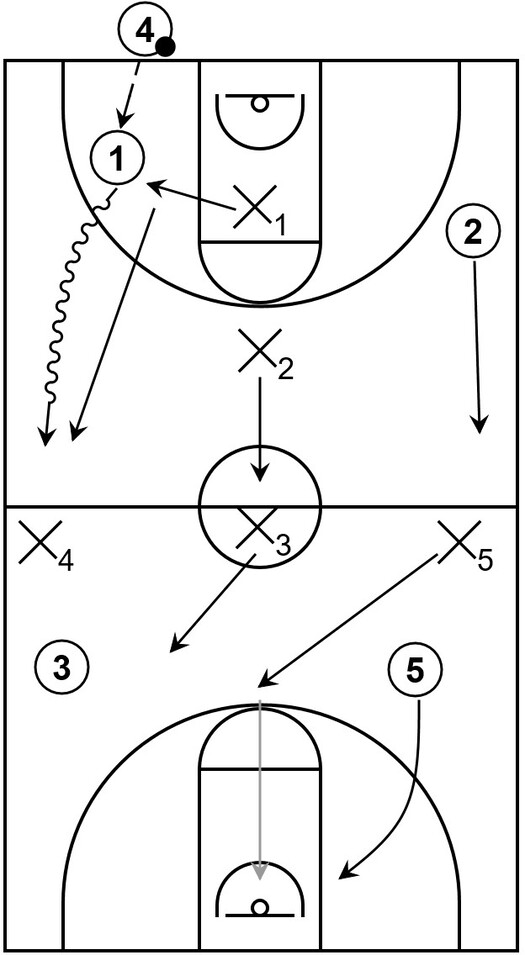
This is an example of initial defensive pressure within the 1-1-3 press that could occur when an offensive player receives the basketball in their backcourt.
Essentially, 1 receives the ball from 4 and then X1 influences 1 to dribble towards the sideline.
As that occurs, X4 is in preparation to set a potential trap while X2 covers the middle to possibly hinder or prevent any passes within that area.
Additionally, X3 slides to the ball side wing area while X5 slides towards the top in the middle above the three-point line.
Furthermore, if an offensive player such as 5 begins to cut below the free throw line extended area towards the basket, then X5 can also drop back to protect the basket, as indicated by the gray arrow on the diagram.
Example 2: Potential trap near sideline immediately after ball crosses into frontcourt
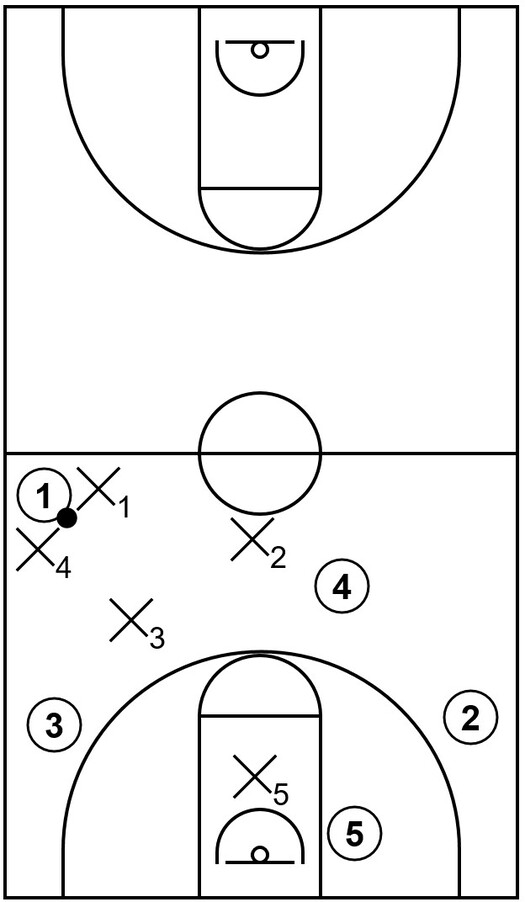
This is an example of a potential trap within the 1-1-3 press that could lead to a possible turnover.
Basically, X1 and X4 set the trap near the sideline and half court line immediately after 1 dribbles the basketball into the offensive team’s frontcourt.
In addition to that, X2 protects the middle area after sliding down from the offensive team’s backcourt.
Moreover, X3 continues to cover the ball side wing area, looking to intercept any potential passes near that area. Finally, X5 continues to protect the basket.
Example 3: Potential trap near wing area
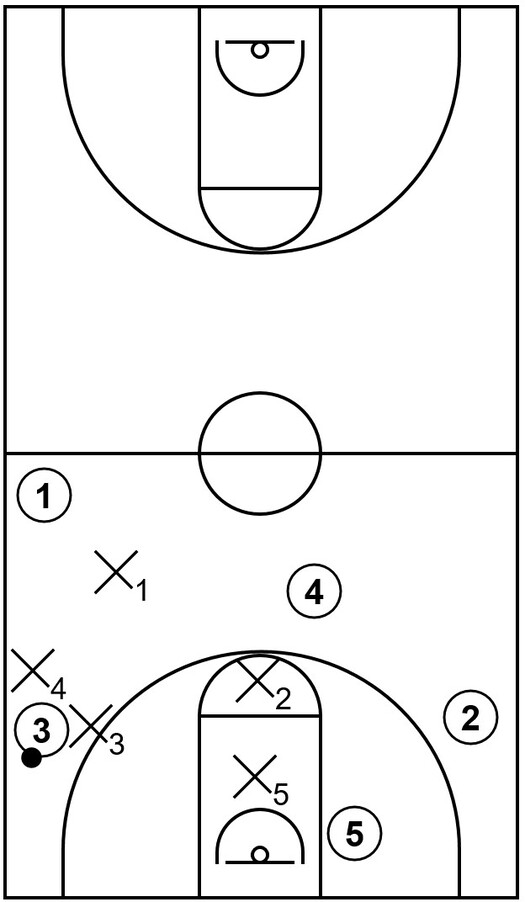
This is an example of a potential trap within the 1-1-3 press that could occur if an offensive player receives the ball on the wing in their frontcourt.
In essence, X3 and X4 set a trap near the wing area while X1 slides down slightly from the previous diagram to occupy space near the extended slot area.
X1 could also possibly intercept a pass that is thrown back to 1 if that were to occur. Additionally, X2 slides down from the previous diagram to occupy the high post area.
X2 could also potentially intercept a pass thrown to 4 or perhaps even deflect a skip pass thrown cross court with 2 as the recipient.
Example 4: Defensive actions after backwards pass in backcourt
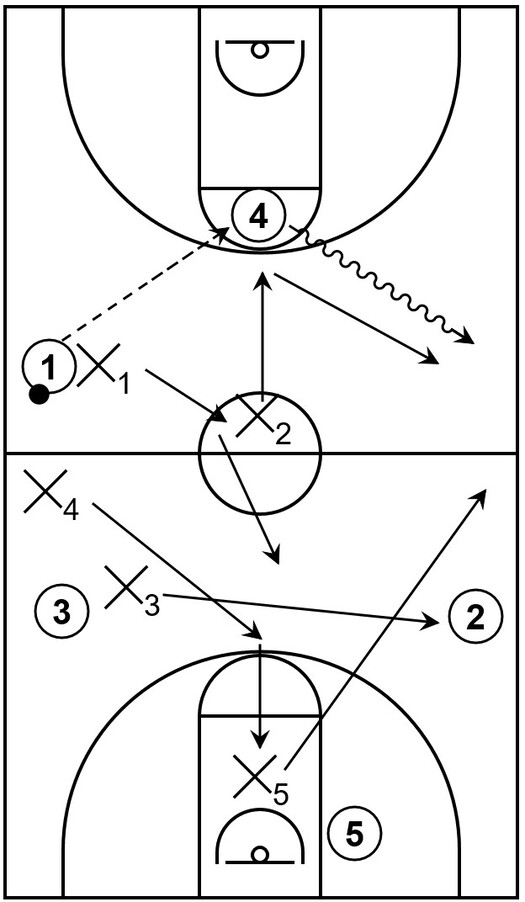
This is an example of what could possibly happen if an offensive player throws a backwards pass in the backcourt prior to the potential trap near the sideline.
For this scenario, let’s say that 1 sees the trap coming in advance. So, when that happens, 1 doesn’t dribble into the frontcourt. Instead, 1 passes the ball backwards with 4 as the safety receiver.
As a result, X2 should immediately sprint up to put pressure on the ball and try to force 4 down the sideline. For this case, 4 begins to dribble towards the sideline.
At the same time, X1 should slide across to protect the middle, initially in the backcourt and then within the frontcourt if necessary.
Also, X3 has to sprint across to cover the opposite wing area, which would be the left side wing from the offensive team’s perspective.
While that occurs, X4 should slide towards the top above the three-point line to initially protect that area. However, X4 could slide down into the lane to protect the basket if an offensive player is below the free throw line extended as in the case of 5.
Additionally, as the backwards pass and sideline push happens, X5 has to sprint as fast as possible to occupy the corner space near the half court line.
It is very important that X5 sprints really hard because X5 will be in position to set a potential trap on this new side with X2.
Example 5: Potential trap near sideline immediately after ball crosses into frontcourt
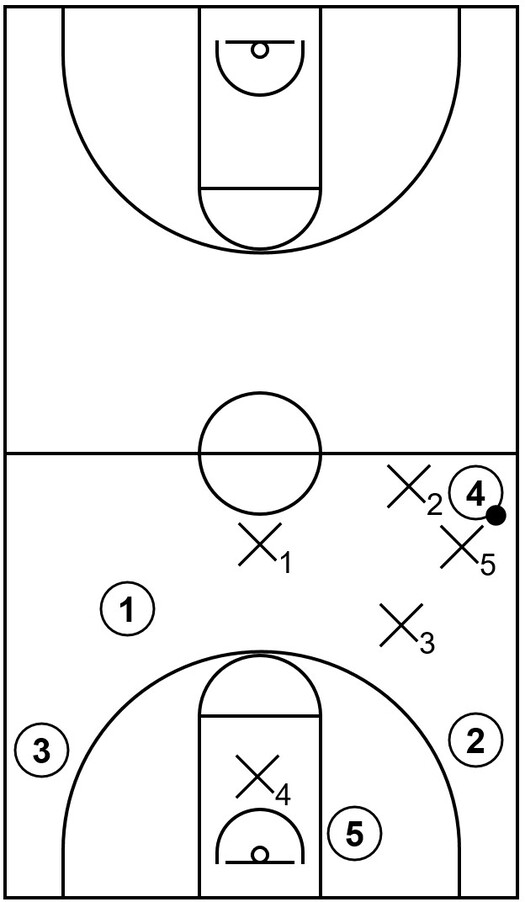
This is an example of another potential trap, this time on the opposite side of the court.
In essence, X2 and X5 set the trap near the sideline and half court line immediately after 4 dribbles the ball into the offensive team’s frontcourt.
What’s more, X1 protects the middle area after sliding down from the offensive team’s backcourt.
Additionally, X3 guards near the ball side wing area, looking to intercept any potential passes near that area while X4 protects the basket.